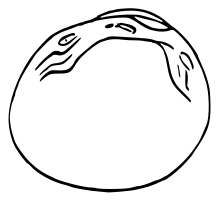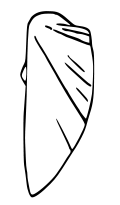Pisidium
| Pisidium | |
|---|---|
 | |
| External view of the left valve of Pisidium pseudosphaerium | |
| Scientific classification | |
| Kingdom: | Animalia |
| Phylum: | Mollusca |
| Class: | Bivalvia |
| Subclass: | Heterodonta |
| Order: | Veneroida |
| Suborder: | Sphaeriacea |
| Family: | Sphaeriidae |
| Subfamily: | Pisidiinae Gray in Turton, 1857 |
| Genus: | Pisidium Pfeiffer, 1821 |
Pisidium is a genus of very small or minute freshwater clams known as pill clams or pea clams, aquatic bivalve molluscs in the family Sphaeriidae, the pea clams and fingernail clams.
In some bivalve classification systems, the family Sphaeriidae is referred to as Pisidiidae, and occasionally Pisidium species are grouped in a subfamily known as Pisidiinae.



Pisidium and taphonomy
In large enough quantities, the minute shells of these bivalves can affect environmental conditions, and this change in conditions can positively affect the ability of organic remains in the immediate environment to fossilize (one aspect of taphonomy).[1] For example, in the Dinosaur Park Formation, the fossil remains of hadrosaur eggshells are rare.[2] This is because the breakdown of tannins from the local coniferous vegetation caused the ancient waters to be acidic, and therefore usually eggshell fragments dissolved in the water before they had a chance to be fossilized.[3]
Hadrosaur eggshell fragments are however present in two microfossil sites in the area. Both of these sites are dominated by preserved shells of invertebrate life, primarily shells of pisidiids.[2] The slow dissolution of these minute bivalve shells released calcium carbonate into the water, raising the water's pH high enough that it prevented the hadrosaur eggshell fragments from dissolving before they could be fossilized.[4]
Extant subgenera and species
Extant subgenera and species within the genus Pisidium include:
subgenus Euglesa Jenyns, 1832
- Pisidium casertanum (Poli, 1791)
- Pisidium globulare Clessin, 1873
- Pisidium personatum Malm, 1855
subgenus Pisidium Pfeiffer, 1821
- Pisidium amnicum (O. F. Müller, 1774)
- Pisidium dilatatum Westerlund, 1897
- †Pisidium clessini Neumayr, 1875
subgenus Cyclocalyx Dall, 1903
- Pisidium hinzi Kuiper, 1975
- Pisidium obtusale (Lamarck, 1818)
subgenus Tropidocyclas Dall, 1903
- Pisidium henslowanum (Sheppard, 1823)
- Pisidium lilljeborgii Clessin, 1886
- Pisidium supinum A. Schmidt, 1851
- Pisidium waldeni Kuiper, 1975
subgenus Henslowiana Fagot, 1892
subgenus Hiberneuglesa Starobogatov, 1983
- Pisidium hibernicum Westerlund, 1894
subgenus Cingulipisidium Pirogov & Starobogatov, 1974
- Pisidium crassum Stelfox, 1918
- Pisidium milium Held, 1836
- Pisidium nitidum Jenyns, 1832
- Pisidium pseudosphaerium Favre, 1927
subgenus Pseudeupera Germain, 1909
- Pisidium pulchellum Jenyns, 1832
- Pisidium subtruncatum Malm, 1855
subgenus Neopisidium Odhner, 1921
- Pisidium conventus Clessin, 1867
subgenus Odhneripisidium Kuiper, 1962
- Pisidium moitessierianum Paladilhe, 1866
- Pisidium tenuilineatum Stelfox, 1918
subgenus Afropisidium Kuiper, 1962
- Pisidium giraudi Bourguignat, 1885
- Pisidium hodgkini (Suter, 1905)
- Pisidium pirothi Jickeli, 1881[5]
subgenus ?
- Pisidium artifex Kuiper, 1960[6]
- Pisidium stewarti Preston, 1909[7]
subgenus incertae sedis
- Pisidium annandalei Prashad, 1925
- Pisidium edlaueri Kuiper, 1960
- Pisidium maasseni Kuiper, 1987
- Pisidium punctiferum (Guppy, 1867)
- Pisidium raddei Dybowski, 1902
- undescribed Pisidium species from Africa (Kuiper, in prep., awaiting additional records)[8]
Footnotes
- ↑ Tanke and Brett-Surman (2001).
- 1 2 "Abstract," Tanke and Brett-Surman (2001). Page 206.
- ↑ "Discussion," Tanke and Brett-Surman (2001). Page 212.
- ↑ "Eggshell," Tanke and Brett-Surman (2001). Page 209.
- ↑ Appleton C., Ghamizi M., Jørgensen A., Kristensen T. K., Lange C., Stensgaard A-S. & Van Damme D. (2009). Pisidium pirothi. In: IUCN 2010. IUCN Red List of Threatened Species. Version 2010.4. <www.iucnredlist.org>. Downloaded on 3 December 2010.
- ↑ Lange C. N. & Ngereza C. (2004). Pisidium artifex. 2006 IUCN Red List of Threatened Species. Downloaded on 7 August 2007.
- ↑ Bogan A. (2011). Pisidium stewarti. In: IUCN 2012. IUCN Red List of Threatened Species. Version 2012.2. <www.iucnredlist.org>. Downloaded on 1 November 2012.
- ↑ Kuiper J.G.J. (2009). "Fossil records of Palaearctic Pisidium species in tropical Africa". Zoologische Mededelingen 83(10): 593-594. HTM.
References
- Tanke, D.H. and Brett-Surman, M.K. 2001. Evidence of Hatchling and Nestling-Size Hadrosaurs (Reptilia:Ornithischia) from Dinosaur Provincial Park (Dinosaur Park Formation: Campanian), Alberta, Canada. pp. 206–218. In: Mesozoic Vertebrate Life—New Research Inspired by the Paleontology of Philip J. Currie. Edited by D.H. Tanke and K. Carpenter. Indiana University Press: Bloomington. xviii + 577 pp.
External links
| Wikimedia Commons has media related to Pisidium. |
- Pisidium keyed, described and illustrated in Danmarks Fauna (Georg Mandahl-Barth)
- Pisidium images at Consortium for the Barcode of Life
- http://sunsite.ualberta.ca/Projects/Aquatic_Invertebrates/?Page=20